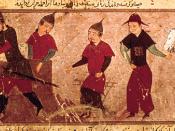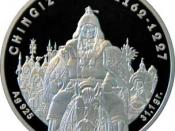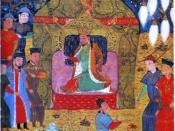THIS WAS LIMITED TO A 1-2 PAGE ESSAY ANSWER (TIMED) FOR A MIDTERM EXAM
Question:
From your readings thus far compare and contrast the style of commands of Ghengis Kahn and Napoleon with specific reference to Strategy and Operations, and army organization. In what areas did they succeed over their contemporaries?
My Answer:
Almost 600 years separated the rise of Genghis Khan and Napoleon Bonaparte--The former finalizing his claim to power at the demise of the Kereit in 1203, and the latter excepting the lead role in the coup d'etat in 1799. When general, simplified principles are observed, one can already distinguish a common thread that linked the two great warriors. Amazingly, their common strategies were implied despite army organizations were anything but similar. The Mongolian Army was cavalry "pure," that is, the Mongolians fought from horseback and were masters at horsemanship and archery, and relied very little on (and not until after Genghis' successes) the augmentation of infantry forces from the subjugated territories.
Napoleon, as was one of his many claims to fame, especially as his rise to power paralleled the rise in gunpowder-related panoplies of Europe, relied heavily on his own mastery of artillery (no less than nine of his maxims relate to the artillery or artillery officer roles). This is not meant to imply Genghis was ignorant of the siege and siege-weaponry of his era, but like, Napoleon, he chose to abstain from siege warfare whenever possible, and therefore, the reliance on a cavalry-pure army was upheld.
Before discussing the strategic similarities of the two generals, the similarities in the army organization must be realized. As was mentioned above, the actual organization of the two armies was as different as two armies could possibly be: Mongolia's "Cav-Pure" and Napoleon's well organized combined-arms army with heavy reliance...



Very interesting
never really thought of it
5 out of 6 people found this comment useful.